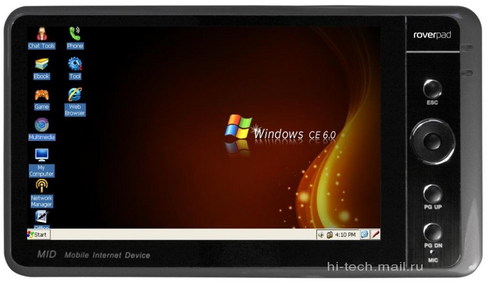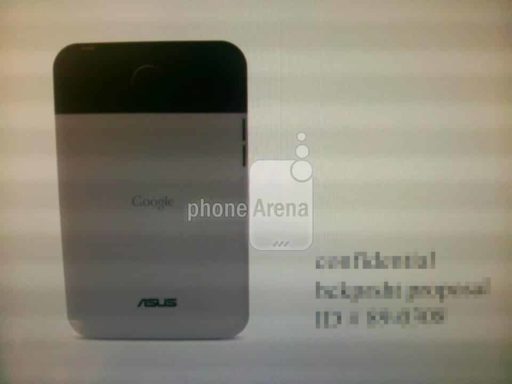The success of the Apple iPad forced to consider other manufacturers of mobile technology on the issue of similar devices. Leading international and local manufacturers, one way or another, interest in the tablet. Russian Rover Computers among them. Exclusively for readers of hi-tech.mail.ru all five models of future new line RoverPad before the official announcement……

The company Rover Computers before the end of 2010 expects to almost completely withdraw from the retail notebook market and focus on selling netbooks and tablets, said company president Sergei Shunyaev. In the segment of tablets, he said, the company will compete with Apple: Rover device designed for the same purpose as the iPad, but aimed at the lower price segment.
And here you were thinking this whole “tablet revolution” thing was a myth, huh? Out of seemingly nowhere, Russia’s own Rover Computer has just issued not one, not two, but five new tablet PCs for its nine time zones, with one of ’em boasting Windows CE 6.0 and the others running on Google’s Android system. Kicking things off is the Air G70, which will boast a 7-inch resistive touchscreen, a 667MHz ARM11 CPU, 256MB of RAM, a 4GB internal flash drive, WiFi, optional 3G and a microSD expansion slot. Next up is the Go G50, Android-powered 5-inch slate that relies on a Marvell PXA303, 128MB of RAM, 2GB of storage as well as 3G, WiFi, a microSD slot and a USB socket. Going even smaller is the aptly-named Air G70, which checks in with a 4-inch display (800 x 480 resolution, though), support for a multitude of file formats and compatibility with navigation software.
So, five tablets, which will be issued by only one will be supplied with operating system Windows CE. They will model RoverPad Air G70. This 7-inch plate with a resistive screen with a resolution of 800 x 480 pixels. He will receive Samsung ARM11 processor with 667 MHz, 256 MB RAM, together with 4 GB flash-drive, whose capacity can be expanded with memory cards microSD, and modules WiFi and 3G. The device will also be endowed with the ports of USB, which can be installed flash-stick or USB-keyboard, headphone output and TV-output. If want to watch the video, not alone but in the company, the availability of the speakers will be very helpful. Yes, the tablet supports playback of audio in MP3, WMA, OGG, WAV, ADPCM and video in MPEG-4, H.264, WMV/VC-1, MPEG-2 and H.263 (720 x 480).
Naturally, the device can be used as an electronic book. Support appropriate formats available. RoverPad Air G70 supports fb2, HTML, CHM, Palmdoc, zTxt, RTF, along with graphic JPEG, GIF, PNG, BMP. In addition, a software solutions from a mail client and browser, but from the hardware orientation sensor, camera 3 megapixel camera, and FM-transmitter weight RoverPad Air G70, along with a battery as much as 5200 a little over 450 g, and this is when dimensions 210x119x16 mm. Looks pretty good deal, but several confused Windows CE. Still, Android in such a device looks more attractive, so turn to the remaining three tablet, built on the platform of Google.
The smallest tablet Rover based on Android – RoverPad Go G50. This 5-inch baby uses Android 1.5. In the hardware is based on the chip MarvellPXA303, working in pairs with 128 MB RAM, 2 GB complemented by flash-drive. In the tablet has a card reader for media microSD, WiFi module and 3G, GPS-module, and a port USB. Compared with RoverPad Air G70 this tablet is very small and lightweight. When the size 158x88x16mm, weighs 271 grams. It is possible that some users will wear it in your pocket, because it is a little more than the flagship smartphones, are 4-inch screens, though, capacitive rather than resistive. In RoverPad Go G50 screen just resistance, but with a resolution of 800 x 480 resolution, so video playback with resolution up to 720 x 480 pixels in MPEG-4, H.264, WMV/VC-1, MPEG-2 and H.263 difficulties should not arise. Do not have gone unheeded and the function of audio playback, and work with documents.
The third tablet RoverPad Go G72 is also based on Andorid, but will use the Android 1.6. He will receive a 7-inch display with the same resolution as in previous decisions. In general, its characteristics are identical to those of the RoverPad Go G50, but unlike a handheld gadget, it will have a web-camera, two-port USB, and communication is not limited to 3G and WiFi. Tablet will offer Bluetooth module and port Ethernet, and GPS-navigation will be available as an option.
In turn, 7-inch tablet RoverPad TegA W70 will be deprived of port Ethernet. Instead, he will output HDMI. Moreover, it will form the basis Platform NVIDIA Tegra (combines the performance chip with a graphics core and 512 MB RAM), and used the display will be performed on a capacitive technology. He also will be 4 GB flash-memory, USB, WiFi, 3G, web-camera. In general, the possibility of this decision will not be limited to office tasks like word processing or surfing the Internet. They also add video playback to HD-quality, as well as games. We also note that as the OS in RoverPad TegA W70 will be used Android 2.1.
The Go G72 steps it back up to a 7-inch panel, but also throws in a webcam, Bluetooth, GPS chip and a hint of color around the edges. Finally, the 7-inch TegA W70 will hum along with NVIDIA’s Tegra within, and being the flagship that it is, it’ll also include HDMI, 4GB of flash storage, 3G, a webcam, 512MB of RAM, a capacitive touchscreen and Android 2.1. Pricing details have yet to be hammered out across the line, but we’re told to expect the family on store shelves by October.
Resources : gamestyle.ru,engadget.com

